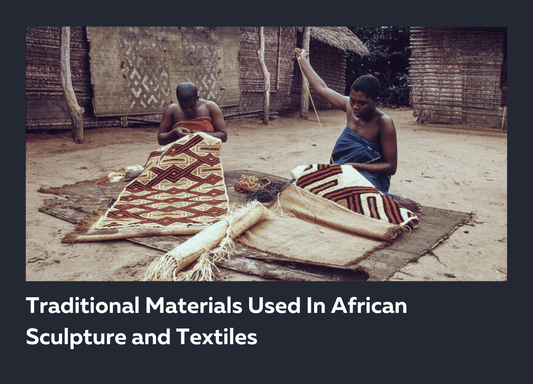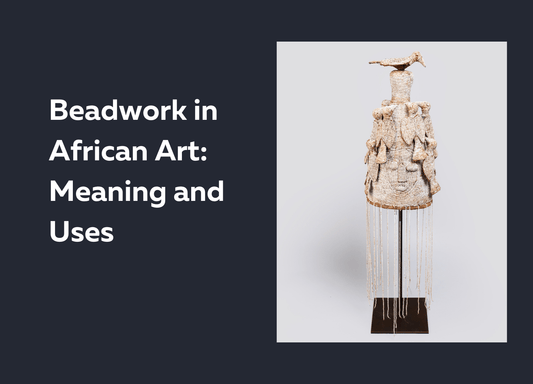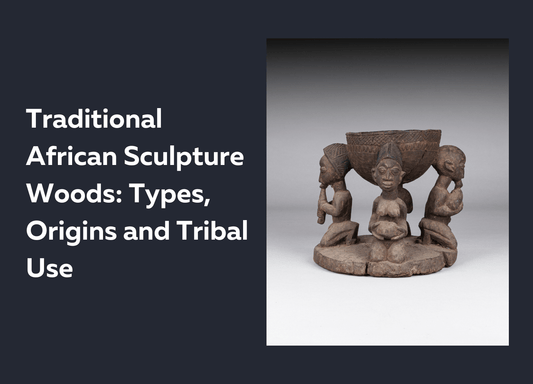
Beadwork in African Art: Regions, Meaning, and Uses
Beadwork is among the most significant and enduring artistic traditions in Africa, employed across a wide range of cultures as a material language of identity, power, spirituality, and memory. Far beyond decorative function, beads are often deeply symbolic, and their usage is tightly embedded in ritual, social, and political systems. This article explores the historical and cultural significance of beadwork in African art, focusing on the regions most associated with this tradition, the materials and forms, and its ceremonial, symbolic, and social uses.
1. Geographic Regions and Cultural Centres of Beadwork
● West Africa
Yoruba (Nigeria)
The Yoruba are among the most accomplished beadworkers in Africa. Their use of imported glass beads dates back to at least the 17th century, following trade with Europe and the Islamic world. Beadwork is most visible in Yoruba royal regalia, especially the Ade (beaded crown), which signifies divine kingship. Other regalia include beaded tunics, shoes, sceptres, and flywhisks. The imagery is not purely ornamental—faces on crowns represent ancestral spirits (orisha) and the link between the king and the divine.

Yoruba beaded crown
Benin (Edo, Nigeria)
Coral beads, often referred to as ivie, were used exclusively by the Oba (king) and nobility of the Benin Kingdom. These beads symbolized power, wealth, and divine authority. The beads, sourced from Mediterranean and Indian Ocean trade networks, were restricted under royal law and featured prominently in altars, garments, and palace architecture.

Oba Ewuare II, 40th Oba of Benin kingdom
● Central Africa
Bamileke, Bamum, and Tikar (Cameroon Grassfields)
Royal courts in Cameroon have developed a distinct aesthetic based on the use of imported European glass beads sewn onto prestige objects: masks, statues, headdresses, and thrones. These bead-covered items symbolise spiritual power, fertility, and status, and are typically used during royal dances and ancestor commemorations. Bead colours often hold symbolic values (e.g., blue for the sky or water spirits, red for vitality or the ancestors).

Bamileke peoples, Chief’s Ceremonial Hat, 1900–1930
● East Africa
Maasai (Kenya and Tanzania)
The Maasai have maintained a complex visual language through beadwork, particularly among women. Beaded collars, earrings, and belts indicate age, marital status, and clan identity. Colour symbolism is prominent: white (purity and milk), red (courage and unity), blue (rain and sustenance). Beadwork is also used in rites of passage, such as circumcision and marriage ceremonies.
Kamba and Samburu (Kenya)
These communities similarly use beadwork in elaborate personal adornments, especially during ceremonies. Bead arrangements often indicate social roles and life transitions, such as warrior initiation or elder status.

Maasai beadwork
● Southern Africa
Zulu (South Africa)
Zulu beadwork is highly codified and was historically used as a method of communication, particularly in romantic or familial contexts. Young women would create beaded messages using a defined colour lexicon. Items such as isicholo (married women’s hats), iqoqwana (love letters in bead form), and beaded aprons were exchanged to express emotional states and intentions.
Ndebele (South Africa, Zimbabwe)
Ndebele women are known for creating large beaded neck rings and aprons, which reflect both cultural heritage and personal milestones. These items are often worn during festivals and communal events.

Ndebele beadwork
2. Materials and Techniques
Historically, African beadwork incorporated organic materials such as ostrich eggshell, bone, seeds, ivory, shell, and stone. With the arrival of European and Islamic traders, glass beads became dominant—favoured for their colour variety, shine, and perceived spiritual potency.
Techniques include:
Sewing beads onto leather or cloth
Stringing beads into geometric or symbolic patterns
Embedding beads into carved wooden sculptures or furniture
Weaving bead panels or wrapping beads around frames

Yoruba beaded staff
3. Symbolism and Meaning
● Spiritual and Ritual Significance
In many cultures, beads are considered sacred objects, used in rituals involving ancestors, divination, and healing. Among the Yoruba, for example, beaded items are imbued with ase—spiritual energy or authority—and worn during trance possession or orisha worship. In the Congo Basin, beaded power figures (nkisi) are used by ritual specialists to access spirit forces.
● Status and Hierarchy
Beads often demarcate social rank. Only royalty, chiefs, or spiritual leaders are permitted to wear certain types or arrangements. In some societies, beads are earned progressively—such as among Pende and Kuba initiates—through ritual advancement.
● Communication and Identity
Beads serve as visual texts. Zulu “love letters” and Maasai bead arrangements encode information about tribe, gender, status, and personal history. This symbolic function is most developed where oral traditions dominate.
While beadwork retains its cultural meanings in many African communities, issues of cultural appropriation, decontextualisation, and restitution are increasingly discussed in academic and museum circles.
Conclusion
Beadwork in African art embodies a fusion of craftsmanship, cosmology, status, and history. From Yoruba crowns to Maasai collars, each bead carries layered meanings that extend far beyond surface aesthetics. At Afrahouse Gallery, we honour this legacy by presenting authentic beaded works that educate and connect our visitors to Africa’s vast and diverse cultural traditions.



